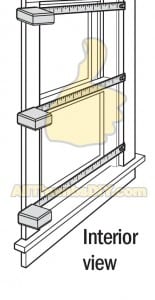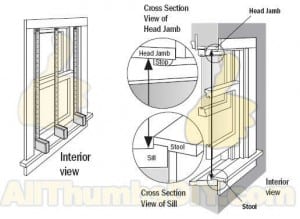In my opinion, replacing old windows is one of the best ways to increase comfort around the house. There is no greater waste than spending hard earned money to heat and/or cool the air in the house only to lose them to those drafty windows!
Today’s windows are almost twice as efficient as the replacement windows manufactured just 6 years ago so if the windows are not working properly, it’s time to replace them!
In this section, I describe in detail how to replace existing double-hung wood windows and flimsy metal side tracks with brand new vinyl replacement windows.
TIP: I suggest reading Build Like Pros – Windows and Doors. This book contains in-depth information about replacing other kinds of widows. Lots of useful reference information that is handy to have around when you find yourself in a challenging situation.
Step 3 – Measurements
Measuring window openings can be the most daunting task of all because incorrect measurements will cause a lot of unnecessary re-work down the road. Heck, I’ve had cases where I needed to re-order some windows because windows came out tool small to even adjust the window openings!
How do I ensure that my measurements come out correctly? Simple. I take my time and accurately measure everything three times. Since my earlier days, I have successfully installed all my replacement windows.
If you are not still unsure of measurements after reading this section, you can always pay for one of the professional installers to come out and measure for you. Your local window retailers as well as one of the big box retailers (Home Depot and Lowes) have these services available.
Step 3.1 – Removing the interior stop (a.k.a. quarter round molding)
The best (but not the easiest) way to get the most accurate measurement is to remove interior stops, also known as quarter-round moldings that cover the left, right and top side of a window.
In addition, I decided to re-use these molding pieces as much as I can to reduce work down the road. If you are replacing these moldings, you can be little bit less careful.
1. Score along the ridge line between the interior trim molding and interior stop (see picture on the right) to break the paint seal;
2. Use a thick-bladed 4″ putty knife to carefully pry off the interior stops. Any flimsy (e.g. cheap) putty knives will simply bend and make the removal process that much more difficult;
3. Gently slide and nudge the putty knife up and down to separate nails and tghe interior stop from the side/top jambs;
4. After removing the interior stop, use a pair of large pliers to remove any remaining nails from the top and side jambs.
Now that the top and side jambs partially exposed, I take an awl (or a screwdriver) and poke around the side/top jambs/window sill to see if they feel solid or soft?
Since a solid framing base is a MUST before proceeding, I need to note and take care of any rotted components first during the window replacement.
Please refer to the Installing Replacement Windows with Rotted sill section to read more about this topic.
Step 3.2 – Taking measurements
There are four critical measurements to take into consideration when measuring for a replacement window:
1. Window “squareness”;
2. Window depth;
3. Window width;
4. Window height;
Is the window square?
Take a diagonal measurement from one top corner to the opposite bottom corner of a window (see left).
Repeat the measurement for the opposite side and compare these two measurements. They should be within 0.25″ from each other. If not, the window opening is out-of-square which means it may require help from a professional to resolve this issue.
Measuring the window depth
Next, measure the window opening depth by measuring the width of a side jamb. Since most houses are constructed with 2″x4″ lumbers, the measurement should be at least 3.25″.
TIP: The actual dimensions on a 2″ x 4″ lumber is 1.5″ x 3.5″ (go figure). Note that the width of a standard lumber matches the depth of my window.
If I had a deeper window (for example, house constructed with 2×6 lumber), I simply would have purchased jamb-extension kits.
Measuring the window depth
To measure the width of a window, I simply take the measurement between left to right jambs.
Alternatively, if the interior stops were not removed, a measurement can be taken from one side of the metal track to the other side (shown right).
For the best result, I recommend taking measurements from jamb-to-jamb. In addition, I need 3 separate measurements: from the top, middle and bottom.
Record the SMALLEST number out of these 3 measurements as the width. Repeat this process 2 additional times to triple check the width measurement.
Measuring the window height
To measure the height, follow the previous the steps, except that measurements are taken from the top jamb to the top part of the window sill.
Take vertical measurements from the left, center, and right sides of a window and record the SHORTEST measurement as the height. Repeat this process 2 additional times to triple check the height measurement.
It is critical that EACH window is measured individually no matter how identical they may look! Eyeballing to assume is a sure way for disaster!
Although measurements for similar windows may be taken without removing the interior stop, measure everything three times before placing an order for your replacement windows!
TIP: Most replacement window manufacturers shrink the width and height dimensions by 0.25 inches when window are manufactured for snug fit. Make sure to inform the salesperson that these measurements are the ACTUAL WINDOW OPENING dimensions!
In terms of selecting a brand/model, I have successfully purchased and installed both Andersen (new construction and replacement windows) and Pella (new construction casement windows and replacement windows) from Home Depot / Lowes.
I’ve heard other people bad-mouth replacement windows from Home Depot / Lowes but so far, I have been very happy with their products and follow-up service.
As with any major purchases, it’s ultimately up to you to research about the brand, quality, warranty, price, etc. before deciding the best option(s) for your given situation.
My window delivery was scheduled in approximately 6-8 weeks, so during this “free” time, I planned: 1) to obtain a building permit (required in my township) and; 2) vacation days. In addition, I started to gather/purchase the following materials:
- Plenty of composite shims (usually 1 pack of 8-10 shims per window). Why use composite shims vs cheaper wood shims? In my experience, wood shims tend to split as you drive a screw, don’t cut cleanly and they tend to slide if stacked with other shims. On the contrast, composite shims do not split, snap off evenly and they stay in place. Because their availability at the big box stores are erratic, it is worthwhile to stock on them when you can get ’em.
- (1) tube of high quality exterior polyurethane or silicone sealant per window;
- Caulking gun
- (1) can Great Stuff Window and Door Insulating foam per 3 windows (note: Use the BLUE canister only – Foams in Red and Black canisters will bow your windows!)
- Loose insulation fill
- Tape measure
- 2ft and 4ft levels
- Utility knife (with extra blades)
- 4″ Putty knife
- Flat-headed pry bar
- Hammer
- Flat and Phillips screw drivers
- Cordless Drill
All Thumbs DIY TIP:I cannot stress enough the importance of purchasing high quality tools. There is nothing that is more frustrating that one your tools failing you during one of the DIY projects. I’ve always had good experience with DeWalt, Craftsman and Ryobi brands. If you cannot afford a new one, purchasing a reconditioned tools is another good way to go. (Check out DeWalt Nano Technology now available at ToolKing.com or their Mark Downs On DeWalt Tools – ToolKing.com)
Although I removed and installed windows by myself, it would be easier if you bring a friend to help you. Also, try to pick a nice warm sunny day as the installation day as the warm (not hot) weather will make the whole process go little bit quicker.
Subsequent sections describe Pella replacement window installations. I plan to include additional sections describing Anderson new construction window installations in the future.








Replacing Leaky Rotted Basement Windows – Part 1 of 3
Sunday 26th of February 2012
[...] Taking measurement was a straightforward process. Like anything else, please make sure to take THREE separate measurements before placing the order. If you want some basic guidelines on how to measure for a replacement window, read this post. [...]